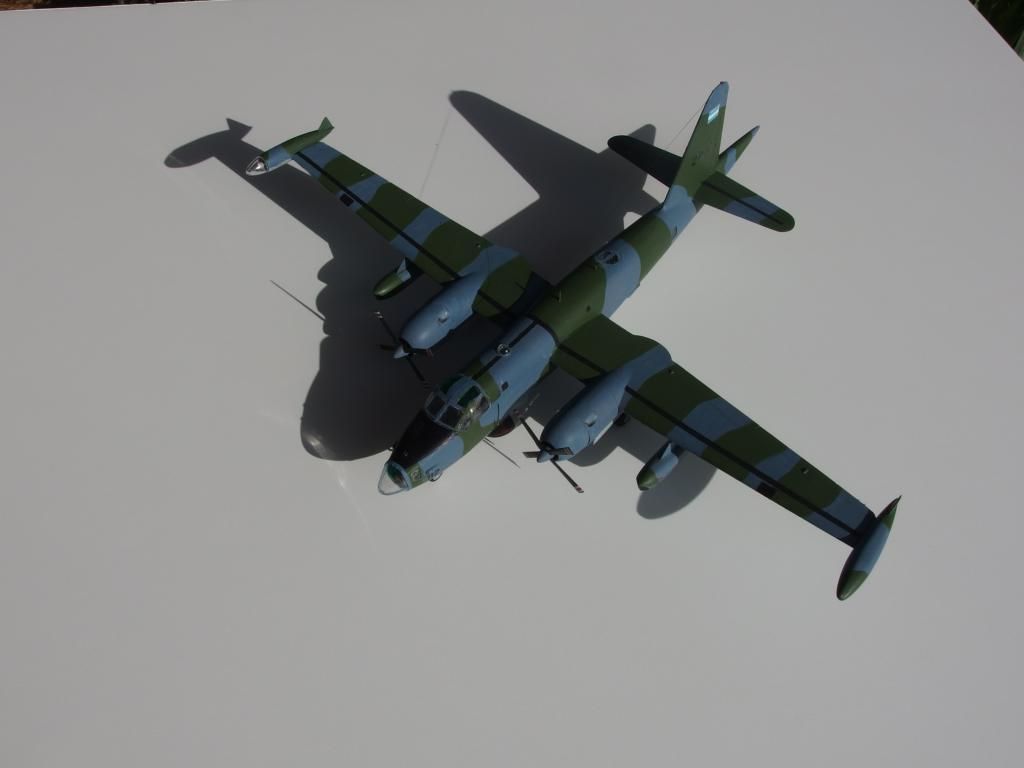Hola, so manana is finally here. Bunch of crud happened the last two weeks, but here is the finished product.
Lockheed Neptune 2-P-112 was one of two Neptune patrol aircraft still operational in 1982 in the initial phase of the Malvinas/ Falkland War.
Originally an SP-2H, ex-RAF, airframe 0708 was acquired by the Armada (Naval Aviation) in 1977. He was painted overall gray over white, with the anchors on the upper wing surfaces.
In 1981 he was repainted in blue over green camouflage during the conflict with Chile.
On May 4, 1982, P-112 left Rio Grande on a flight to locate the approaching British Fleet. Large targets were acquired.
As follows from http://britains-smallwars.com
"The End of the HMS Sheffield
At 5:07 hrs on May 4th 1982, a SP-2H Neptune, serial number 0708/2-P-112, call sign 'Mercurio', belonging to the Exploration Squadron of the CANA, took off from Río Grande Air Naval Base. The plane's crew was composed of three members, and the pilot was Corvette Captain Ernesto Proni Leston (the other members were the copilot and Operative Control Officer, surnamed Pernussi). Originally the mission was to detect any British naval activity to allow a group of C-130s to land on Puerto Argentino's airport, but even when the flight of the Hercules was aborted, the Neptune sortie stands. At 7:50 the Neptune had his first radar contact with a British warship, and Proni reported the news to the CANA. He was ordered to keep contact but with discretion. 'Mercurio' had two other contacts at 8:14 and 8:43. A few minutes later an order from the High Command of CANA arrived to evade any contact until 10:00 hrs. Proni guessed that an Exocet sortie was on the way, and set the Neptune's course to the area of the wreckage of the ARA General Belgrano, pretending to be part of a rescue mission searching for survivors.
The Neptune's path
This was the flight path followed by the Neptune of Corvette
Captain Proni Leston on May 4th 1982.
The news about Captain Proni's findings arrived to Río Grande quickly, and it was the turn for Corvette Captain Augusto César Bedacarratz and Frigate Lieutenat Armando Mayora to fly the anti-ship sorties, and all the other pilots helped to prepare the flight paths, points of meeting with the KC-130H tanker, etc. Both Super Etendards took off from Río Grande at 9:45 hrs. Bedacarratz, the leader, (call sign 'Aries') flew the plane 0752/3-A-202, and Mayora, the wingman, (call sign 'Boina') did so with his plane 0753/3-A-203. At 10:00 hrs they met the KC-130H tanker provided by the FAA (Fuerza Aérea Argentina - Argentine Air Force) piloted by Vicecommodore Pessana and received all the necessary fuel to complete the mission.
At 10:35, Corvette Captain Proni did his last climb at 1,170 meters (3,500 feet) and detected a big contact and two medium-size in the coordinates 52º 33' 55'' South, 57º 40' 55'' West. A few minutes later he radioed both Super Etendards and gave the information to Bedacarratz. After that, Proni set his course to Río Grande and landed at 12:04 hrs. His long sortie had reached the end.
But the mission of the SUEs (nickname given by the Argentine pilots to the Super Etendards) had just begun. Flying at very low altitude, around 10:50 hrs they climbed at 160 meters (500 feet) to verify the coordinates given by Proni, but they found... nothing! Both pilots turned back to searching and Bedacarratz decided to continue. 40 kms (25 miles) later they climbed again and, after a few seconds of scanning, the targets appeared on their radar screens. Both pilots loaded the coordinates in their weapons systems, turned back to low level, and after the last minute check, launched their AM.39 Exocets. The exact time was 11:04 hrs.
During the flight back to the base, Bedacarratz realized that they would not need the KC-130H assistance, and called to Vicecommodore Pessana declining the refuelling. Pessano was then the first Argentine officer to know the success of the mission. Bedacarratz and Mayora landed at 12:04 hrs, exactly an hour after having launched the missiles. It is unnecessary to say that they were received by their happy comrades as heroes."
This is the old Hasegawa kit. It's not bad but it's a real chore to build. I bought the Japanese version, and my good friend Jeremiahs from the Falkland/ Malvinas GB was so kind as to give me the decal set.

